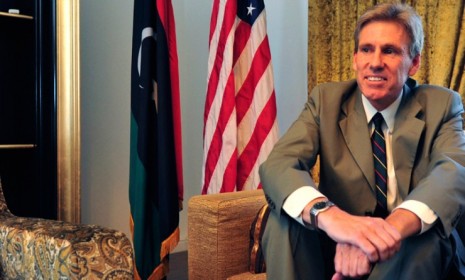The quietly heroic life of Ambassador Chris Stevens
Friends and colleagues mourn the loss of a longtime diplomat who bravely and selflessly put himself in harm's way

State Department veteran Christopher Stevens is the first American ambassador killed in the line of duty since 1979. He died along with three other Americans, including Foreign Service information officer Sean Smith, as suspected Islamist militants attacked the U.S. Consulate in Benghazi, Libya, with gunfire, rockets, and homemade firebombs on Tuesday night. As the Obama administration and the new government of Libya begin the hunt for the killers, friends are mourning the lives lost. "It's especially tragic that Chris Stevens died in Benghazi," President Obama said Wednesday, "because it is a city that he helped to save." Here, a look at Stevens' life, and the still-murky circumstances of his death:
How did Stevens' career start?
After graduating from the University of California at Berkeley in 1982, Stevens joined the Peace Corps, and taught English in the Atlas Mountains of Morocco for two years. It was there, friends say, that he developed a passion for the Middle East, while also impressing colleagues with his kindness. Stevens "was a tall, blond kid who was known, among other things, as the one with the unfailing old-school courtesy toward all," writes Valerie Staats, now the Peace Corps director in Sierra Leone. "He always said he wanted to be an ambassador, and we didn't doubt him."
The Week
Escape your echo chamber. Get the facts behind the news, plus analysis from multiple perspectives.

Sign up for The Week's Free Newsletters
From our morning news briefing to a weekly Good News Newsletter, get the best of The Week delivered directly to your inbox.
From our morning news briefing to a weekly Good News Newsletter, get the best of The Week delivered directly to your inbox.
Where did Stevens work before Libya?
After the Peace Corps, Stevens earned a law degree, and worked briefly as a lawyer. He joined the Foreign Service in 1991, and his diplomatic career took him to Egypt, Saudi Arabia, Israel, and Syria. He also had a stint in Libya from 2007 to 2009. Through it all, he gained a reputation as the "quintessential diplomat," as one former colleague described him. "Chris took his work seriously, but never himself," says Molly Phee, who entered the diplomatic corps with Stevens and now serves in Addis Ababa, Ethiopia. "He was an avid student of Islam and the Middle East, and consistently strove to build the proverbial bridge between our two cultures in the face of sometimes overwhelming antagonism and bitter misunderstanding."
When did he become our ambassador in Libya?
Stevens, 52, went to Benghazi in April 2011 on a Greek cargo ship. He was part of a team of a dozen U.S. diplomats and guards who went into Libya to establish a diplomatic presence while the fight to topple Moammar Gadhafi was still raging. It was his job to be "the eyes and ears for policy makers trying to gauge how to respond to the rebellion under way," says Flavia Krause-Jackson at Bloomberg, "and avert a massacre in that city by Gadhafi forces." When Gadhafi was killed and the rebels won, Stevens was promoted to ambassador, and sworn in by Secretary of State Hillary Clinton four months ago. Colleagues say that Stevens, who was fluent in Arabic, had no illusions about the dangers of his post. "The image of the striped-pants ambassador who goes to cocktail parties," said Jeffrey D. Feltman, under secretary general at the United Nations, "that was not Chris Stephens." Indeed, "as the conflict in Libya unfolded, Chris was one of the first Americans on the ground in Benghazi," Clinton said. "He risked his own life to lend the Libyan people a helping hand to build the foundation for a new, free nation."
A free daily email with the biggest news stories of the day – and the best features from TheWeek.com
Why was Stevens in Benghazi instead of Tripoli?
He was in town for the inauguration of a cultural center that was part of his effort to build closer ties between the U.S. and Libya. In an email to friends and family in July, he noted that Libyans had become more welcoming to Americans and other Westerners since Gadhafi fell, saying, "Let's hope it lasts." According to some reports, he went to the Consulate on Tuesday night, along with members of the embassy staff, to help evacuate the compound after protesters started to attack it.
How was he killed?
Early reports suggested that he and other American diplomats had been trying to escape the compound when their car was hit by a rocket. But U.S. officials now say that Stevens and another American, Foreign Service information management officer Sean Smith, and a security officer took refuge in a safe room as security officers tried to hold back the siege, in which militants allegedly launched an orchestrated attack using assault rifles and rocket-propelled grenades, using the protest as cover. Militants somehow set fire to the building, and the safe room filled with smoke. The security officer got out and returned 45 minutes later, but by then Smith had choked to death on the smoke. Stevens, also overwhelmed by smoke inhalation, had been carried to a hospital by Libyans, but doctors there couldn't revive him.
Sources: Bloomberg, CNN, New York Times, Politico, Wired
-
 Political cartoons for January 3
Political cartoons for January 3Cartoons Saturday's political cartoons include citizen journalists, self-reflective AI, and Donald Trump's transparency
-
 Into the Woods: a ‘hypnotic’ production
Into the Woods: a ‘hypnotic’ productionThe Week Recommends Jordan Fein’s revival of the much-loved Stephen Sondheim musical is ‘sharp, propulsive and often very funny’
-
 ‘Let 2026 be a year of reckoning’
‘Let 2026 be a year of reckoning’Instant Opinion Opinion, comment and editorials of the day